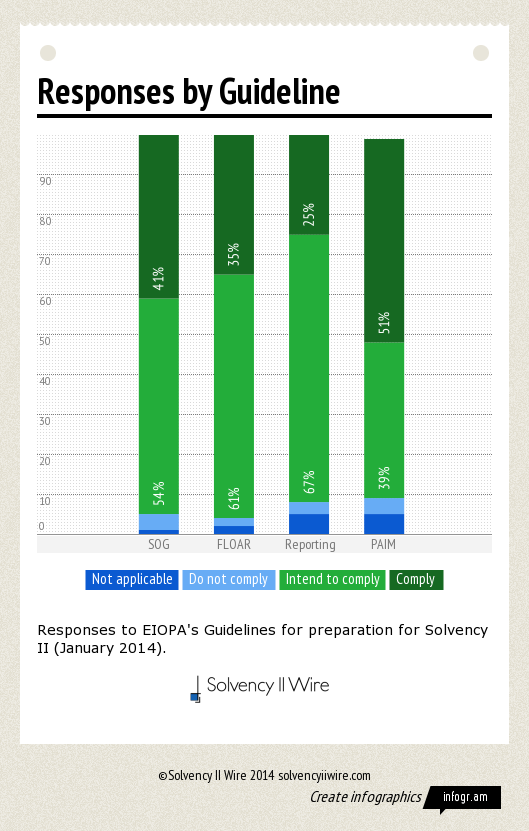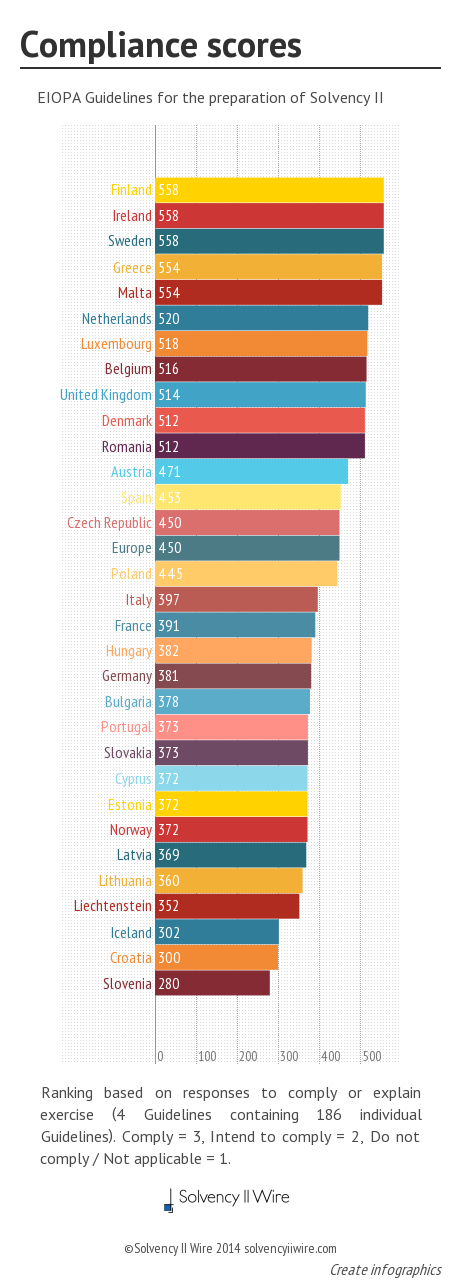
EIOPA’s Guidelines for the preparation of Solvency II, the EIOPA Solvency II Guidelines, have acquired a slightly different meaning as a result of the Omnibus II agreement last November and the certainty about the implementation date. One of the primary objectives of the Guidelines was to keep the momentum after trilogue negotiations stalled in the autumn of 2012.
The Omnibus II agreement shifts the focus to the Guideline’s other objectives: phased-in preparation for Solvency II and a consistent and convergence approach to the preparation across Member States, ahead of the implementation date of 1 January 2016.
Supervisory authorities were given until 31 December 2013 to tell EIOPA their intentions with respect to the Guidelines in a comply or explain exercise. The responses to this exercise can be seen as a barometer for the intentions of both supervisors and industry in the next two years.
Solvency II Wire conducted quantitative analysis of the responses that reveals a strong intention to apply the Guidelines across Europe.
The Guidelines
On 27 September 2013 EIOPA published the final draft of its Guidelines for the preparation of Solvency II. The Guidelines cover four areas of Solvency II preparation:
- SOG – System of Governance (CP-13/08)
- FLAOR – Forward Looking Assessment of Own Risks (CP-13/09)
- Reporting – Submission of Information to National Competent Authorities (CP-13-10)
- PAIM – Pre Application of Internal Models (CP-13/11)
Each one of these four Guidelines contains within it number of Guidelines (e.g. Guideline 5 – Key functions, Guideline 6 – Decision-making, etc.). To avoid confusion, these will be referred to as individual Guidelines. The SOG Guidelines contain 52 individual Guidelines, FLAOR 25 individual Guidelines, Reporting 39 individual Guidelines and PAIM individual Guidelines. Collectively the four Guidelines contain 186 individual Guidelines. The National Competent Authorities (NCA) of the 31 EEA countries that took part in the comply or explain exercise could respond to each one of these 186 individual Guidelines in one of four ways: ‘comply’, ‘intend to comply’, ‘do not comply’ or ‘not applicable’. In case of non-compliance or intention to comply NCAs were asked to explain their action. However, not all the explanations were published.
Survey results
Aggregating the responses to the comply or explain exercise from all 31 NCAs (5,766 responses in total) reveals a number of broad trends across Europe.
NCAs said they will ‘comply’ with 41% of all individual Guidelines and ‘intend to comply’ with 52%, a 93% positive response rate across all individual Guidelines (see chart).
The PAIM Guidelines received the highest percentage of ‘comply’ responses (51% of all individual PAIM Guidelines) followed by SOG (41%), FLAOR (35%) and Reporting (25%).
However, Reporting topped the ‘intend to comply’ responses with 67%, followed by 61% for FLAOR, 54% for SOG and 39% for PAIM.
The sum of both ‘positive’ responses to each of the four Guidelines ranges as follows: FLAOR 96%, Reporting 92%, SOG 90&, and PAIM 90%.
Analysis
Based only on the number of responses to the comply or explain exercise it is clear there is an overwhelmingly positive intention of Member States to take up the Guidelines.
However, the qualitative nature of individual responses reveals further nuance. There are considerable differences in both the methods which NCAs will use to comply with the Guidelines and their own interpretation of the responses to the comply or explain exercise (the former range from using legal requirements to best-effort intention). These differences will be explored below.
Compliance ranking
By assigning a score to each one of the four responses to the comply or explain exercise it is possible to create a ranking of each NCA’s approach to the Guidelines. The table on the left shows the ranking based on the following score weighting: ‘Comply’ = 3 points, ‘Intend to comply’ = 2 points, ‘Do not comply’ = 1 point, ‘Not applicable’ = 1 point.
The last two are equally weighted, as in effect their outcome is identical: non-compliance. Finland, Ireland and Sweden top the list, stating they will comply with all 186 individual Guidelines. They are followed closely by Greece, Malta, The Netherlands and Luxembourg.
The bottom of the list is populated (in descending order) by Latvia, Lithuania, Liechtenstein, Iceland, Croatia and Slovenia. Slovenia, which has the lowest score, responded ‘do not comply’ or ‘not applicable’ to 97 of the 186 Guidelines.
Croatia gave 72 negative responses and Iceland 70. France which sits comfortably in the middle of the pack has a negative score of 58 as it will not comply with most of the SOG and some of the FLAOR Guidelines.
Analysis
The ranking reveals a relatively even distribution of take-up both in terms of market size and geographical spread, although most of Europe’s largest markets lie towards the middle with smaller markets dominating the 1st and 4th quartiles.
The geographic spread is somewhat more evenly distributed although member states in the 4th quartile are predominantly located in the northern and eastern parts of Europe.
As with the analysis of the overall responses, the results need to be viewed in relation to the qualitative responses given by each NCA, and the mechanism it intends to use in order to apply (or reject) the Guidelines.
The results in context
Broadly speaking NCAs can either use regulatory means (such as changes to the legal framework) or supervisory tools (issuing guidance and recommendations) to comply with the EIOPA Guidelines. The latter encompasses a broad range of options including, regulatory guidelines, circulars, or even one-on-one discussions with firms.
Means of compliance with the EIOPA Solvency II guidelines
A flavour of these differences can be gained by examining the responses of the three Member States that said they will comply with all the Guidelines (Finland, Ireland and Sweden).
Ireland issued a set of regulatory guidelines for each of the four Guidelines. The Central Bank of Ireland said in the introduction to its Guidelines that it “expects insurance and reinsurance undertakings to comply with these guidelines and they may be used as a benchmark against which compliance with existing statutory requirements is assessed.”
Meanwhile in Sweden the Swedish Financial Supervisory Authority simply said it will comply with the Guidelines through supervision and stated it will take “appropriate actions in order to encourage the undertakings and insurance groups to prepare for Solvency II.”
The Finnish Financial Supervisory Authority did not give an explanation or details of how it will comply.
Interpretation of responses to the EIOPA Solvency II Guidelines
Further distinction can be found in NCA’s interpretations of the four possible responses to the comply or explain exercise. Examining some of the ‘intend to comply’ responses is revealing. In some Member States the necessary legislation is in the process of being drawn up whereas in others it does not exist, but the NCA still intends to apply the Guidelines – often on a best effort basis. Germany said it intends to comply with most of the SOG Guidelines. BaFin explained it will do so “by way of close multi-stage dialogue with the undertakings and a topic-specific announcement[s] in its official bulletin or on its official website.”
France said it intends to comply with the reporting Guidelines “through requesting undertakings and groups to submit information covered by the guidelines.”
Italy, which already has a legal framework for introducing many of the Guidelines, said in relation to the SOG Guidelines, that for those Guidelines where the legal framework is missing it intends to introduce the principles of the Guidelines by a mix of tools, including updating existing regulation as well as issuance of “soft regulation”.
Some of these responses appear close in reasoning to the ‘comply’ answers given by those NCA’s that said they will fully comply with the Guidelines. Compare, for example, Sweden’s “appropriate actions in order to encourage the undertakings and insurance groups to prepare” with France’s “requesting undertakings and groups to submit information covered by the guidelines”.
More work is needed to fully understand the range of responses and their potential implications on the ground.
Mixing non-compliance with over-compliance
Another example of differing interpretations can be found in the non-compliance responses (‘do not comply’ or ‘not applicable’). These are most commonly linked to groups, where either groups or lead groups do not operate in the specific country (Bulgaria, Croatia and Lichtenstein, for example).
In some cases, however, non-compliance is understood to mean over-compliance as the NCA intends to apply the Guidelines beyond the recommended EIOPA thresholds. This is particularly common in relation to reporting and ORSA.
Conclusion
The results of the EIOPA Solvency II comply or explain exercise show that there is a broad acceptance of the EIOPA Guidelines and strong intention to apply them.
However, the broad range of compliance methods that NCAs intend to use and their varied interpretations of the answers to the exercise suggest that while the Guidelines may achieve their objective of phasing-in the preparation of Solvency II, achieving a consistent and convergent approach across Europe may prove challenging.
Details of NCA’s responses to the comply or explain exercise are summarised in
Solvency II Wire’s interactive map of EIOPA’s Solvency II preparatory Guidelines.









